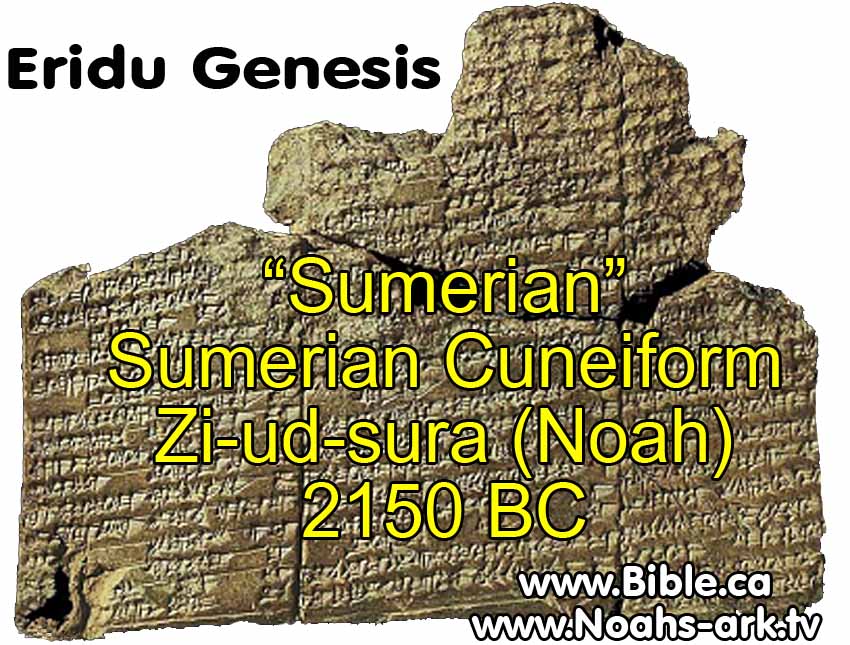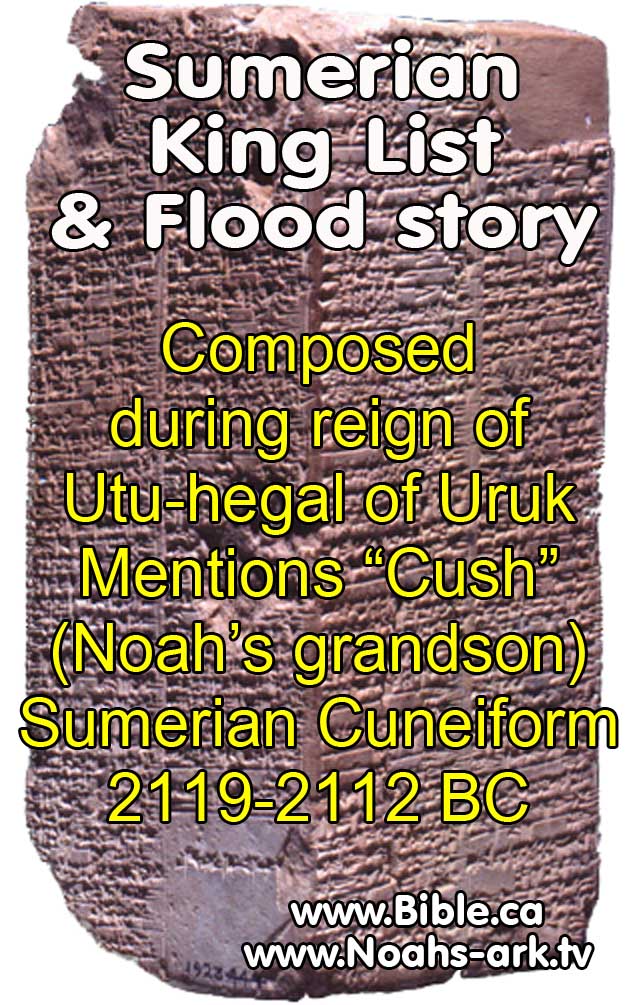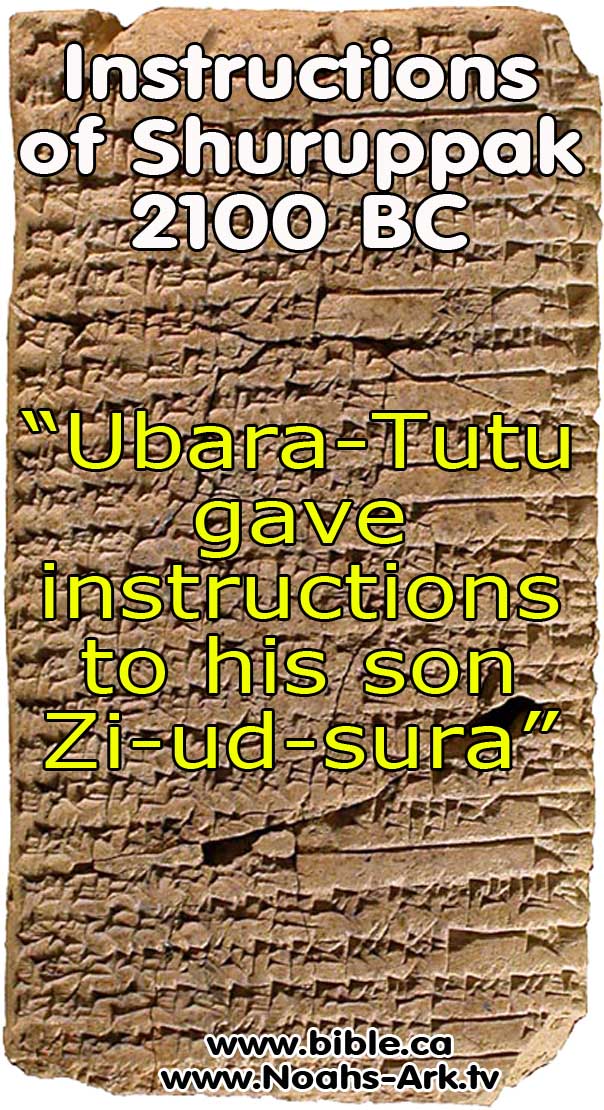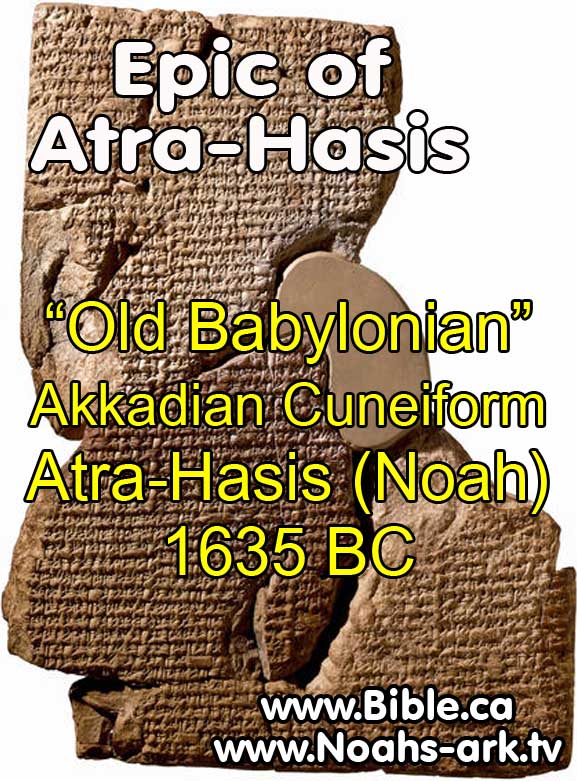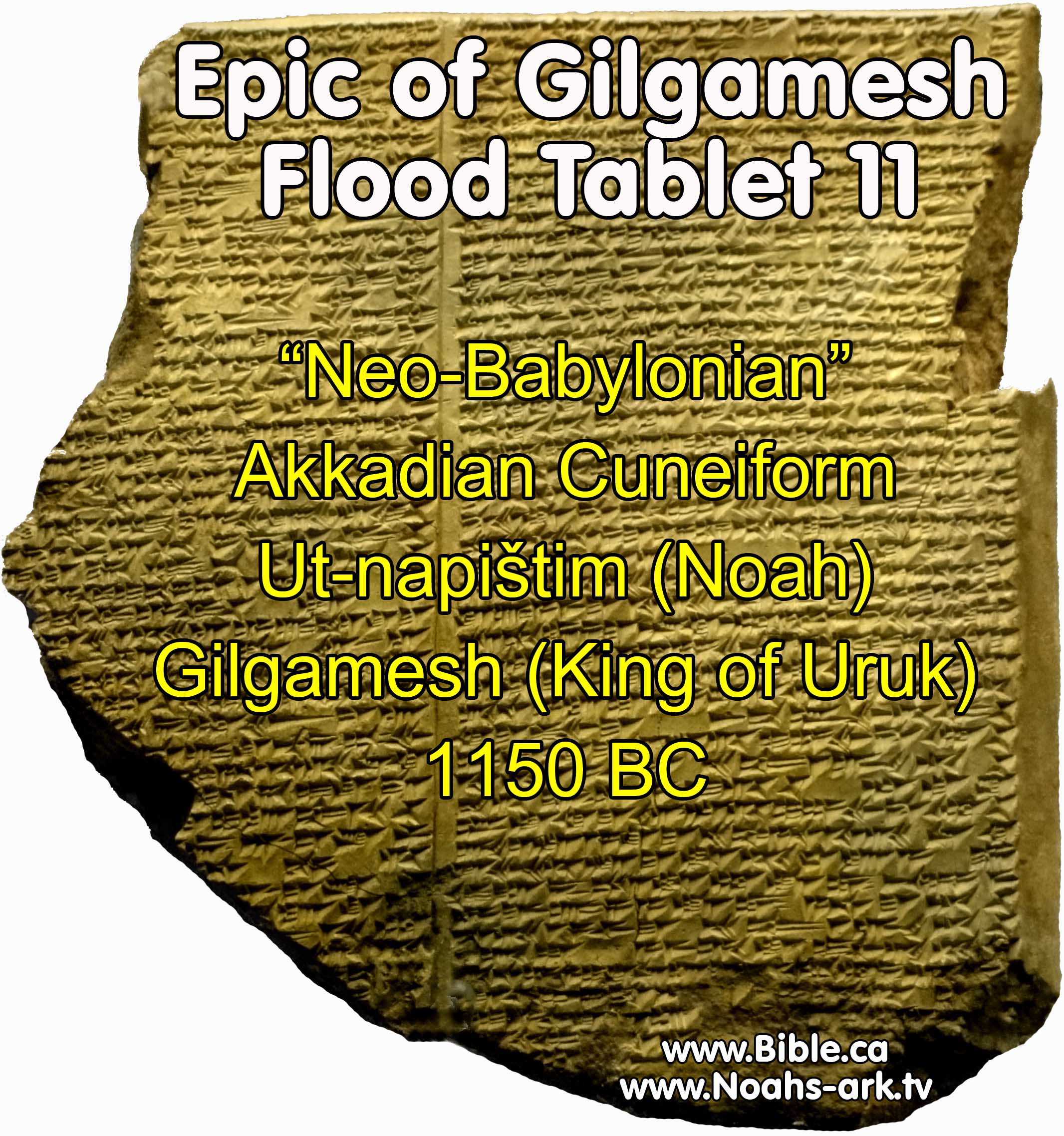The Search for Noah's Ark with Steven Rudd
|
Berossus: Babyloniaca or History of Babylonia 280 BC |
|
|
|
In 280 BC, Berossus wrote Babyloniaca (History of Babylonia) Berossus records a creation, flood and tower of Babel story. More importantly, he states that the location of Noah's ark was known and that people climbed Mt. Ararat to collect bits of wood to be used as lucky charms to ward off evil. Quoted by Abydenus (200 BC), Apollodorus (160 BC), Alexander Polyhistor (50 BC), Josephus (110 AD), Georgius Syncellus (800 AD), Eusebius, (325 AD) it shows that Noah's ark a historical fact since many people had seen it with their own eyes. |
||
Introduction:
1. The fascinating thing is that Berossus clearly states that the Ark existed in 380 BC as a matter of common fact and that people actually climbed Mt. Ararat to gather wood to be used a lucky charms to ward off evil.
2. Oannes
is a fiction invented by Berossus: "an animal destitute of reason, by
name Oannes, whose whole body (according to the account of Apollodorus) was
that of a fish; that under the fish's head he had another head, with feet also
below, similar to those of a man, subjoined to the fish's tail" (Georgius
Syncellus (800 AD) Chronicle 28., quotes from Eusebius (325 AD), Eusebius
Chronicle 5. 8., who quotes from Alexander Polyhistor (50 BC) who in turn was
quoting Berossus who wrote in 380 BC.)
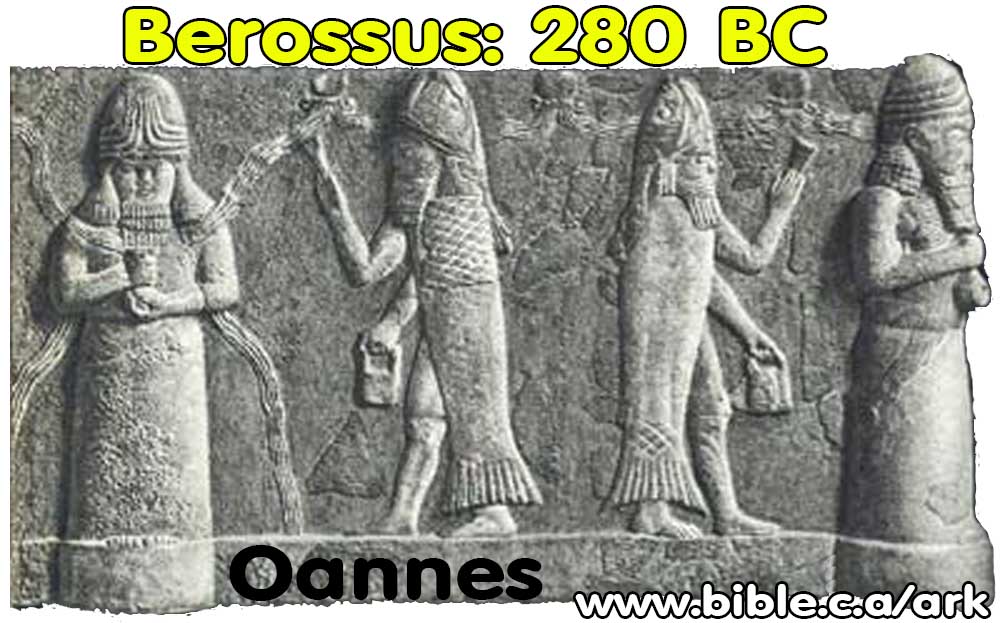
3. Berossus' flood story, follows the Atra-hasis (1635 BC) account closely.
2. Berossus' has an account of creation, the flood and the tower of babel in his book "The History of Babylon" written in 280 BC. Berossus' book, is not as important as the earlier documents, like the Sumarian Kings list, the Eridu Genesis, the Epic of Atra-Hasis or the Epic of Gilgamesh, because of its late date (280 BC). It is clear that Berossus copied from these previous works in his book as source materials.
3. We have no extant manuscripts of Berossus book called, "The History of Babylonia". However, several others quote from him in exerts from his book. This is the only evidence we have of Berossus' work. For example, in 800 AD, Georgius Syncellus quotes from Eusebius [325 AD] who quotes from Alexander Polyhistor [50 BC] who in turn was quoting Berossus who wrote in 380 BC. This is typical of how ancient writings have come down to us.
4. We know Berossus' "The History of Babylon" existed because the following historical writers quote from the book: Abydenus (200 BC), Apollodorus (160 BC), Alexander Polyhistor (50 BC), Josephus (110 AD), Georgius Syncellus (800 AD), Eusebius, (325 AD)
5. Oannes was the fish-man invented by Berossus.
6. In Berossus' flood story, "Xisuthrus" (or Sisithrus) is the one who was on the ark during the great flood. His identity is either Noah, Shem, Ham or Jephath. Sisithrus was most likely Ham, given the fact that Ham's grandson was Nimrod who built the tower of Babel and that the story takes place in Babylon.
A. Overview of the flood story told by Berossus from those who quoted him:
1. From Abydenus (200 BC): Berossus lists ten kings that lived before the flood ending with Xisuthrus (or Sisithrus) who was on the ark. Interesting that this parallels the Genesis chronology that there were 10 descendants from Adam to Noah. The gods commanded to Xisuthrus to "deposit all the writings whatever which were in his possession, in the city of the Sun in Sippara". This is an element that is entirely foreign to any of the older flood stories. This of course is where, in 1830 AD, Joseph Smith got the idea when he wrote the book of Mormon, that the angel Moroni told him to dig up the golden Nephi Tablets with "Reformed Egyptian" (a non-existent language) from upstate New York, which had been buried centuries before by the Nephites. Paralleling several other flood stories and the Bible, Xisuthrus sends out three sets of birds after the flood to see if the water had receded. Like every other flood story, except the Bible, Xisuthrus is granted eternal life when he leaves the ark by the gods.
2. From Apollodorus of Athens (160 BC): Like Abydenus (200 BC), Apollodorus records ten generations of kings where the last one is "Xisuthrus who reigned eighteen Sari: in his time happened the great deluge". Again there may be a connection here with the ten generations from Adam to Noah.
3. From Alexander Polyhistor (50 BC) Creation account: The most complete account of Berossus' flood story comes to use through Alexander Polyhistor who quotes a lengthy passage. He begins by describing the a widely mythical creation story, including the fish man "Oannes". Then, man was created when a god took off his head and mixed the blood that came out with clay. In Gilgamesh, the fallen god become man "Ekidu" was initially created by taking the blood of a god and mixing it with clay. Then the gods created the 5 known planets in 280 BC. In 610 AD, Muhammad, the founder of Islam, continued the pagan tradition of walking seven times counterclockwise around the Kabbah in Mecca. He used the meteorite (black stone) that was built into one corner of the 30 foot cube shaped Kabbah as a counting reference point to mark off 7 revolutions, one for each planet. Of course, Muhammad's Allah must have forgot that he had created 9 planets. If Islam had started in 280 BC, Muslims today would make 5 counterclockwise circuits around the Kabbah.
4. From Alexander Polyhistor (50 BC) Flood account: Berossus' flood account as copied by polyhistor, starts with the statement that "Xisuthrus reigned eighteen sari. In his time happened a great Deluge", then goes on to tell the story. Cronus, the Greek god of time, from which we get the word "Chronology", announces to Xisuthrus there is going to be a global flood and that all mankind is going to be destroyed. He was told to write a history and bury it in Sippara. He was also ordered to make a boat 5 x 2 stadia in size. Berossus, who follows the Atra-Hasis account closely, and has the ark an enormous "five stadia in length, and two in breadth". This translates to a boat 3034 x 1213 feet or 833 x 2083 cubits! In Gilgamesh, Utnapishtim's boat was a perfect cube of 120 x 120 x120 cubits [displacement 228,500 tons] with 7 decks with 9 vertical compartments (63 total) with one door and window. Atra-Hasis' boat was shaped like a large blimp. (Noah's Ark was 300 x 50 x 30 cubits [displacement 43,300 tons] with three decks, one door and window.) Xisuthrus is told to take his friends and family onto the boat along with all the birds and animals. Xisuthrus is told he will sail "to the gods". Not in any previous flood story, Berossus says that there was a pilot to sail the boat. Paralleling Noah and Gilgamesh (1150 BC), Xisuthrus releases three sets of birds to test if the waters have receded. We are not told what kind of birds, but he second set came back with muddy feet and the third set never returned. The ark rests on the Corcyrĉan mountains of Armenia. Gilgamesh says it was Mt. Numush, where as the Bible says Mt. Ararat. But he key, is that the ark rested on the top of a mountain. Similar to Sumerian Eridu (2150 BC) story where Zi-ud-sura drills a hole in the ark, here Berossus records that Xisuthrus "made an opening in the vessel and upon looking out found that it was stranded upon the side of some mountain". They all got out and sacrificed animals to the gods. The began using the ark as a house to live in. However one day, Xisuthrus and some of the families just walked away, not to be seen again. They were able to still hear his voice ordering them to make sure they obey the gods. The gods took notice of this devotion and preaching to obey the gods and they turned Xisuthrus, his wife, daughter and pilot of the boat, into gods. They were then ordered back to Babylon where they should "search for the writings at Sippara, which they were to make known to all mankind". This is where Joseph Smith got the idea to dig up the ancient history of the Nephites and publish the book of Mormon and make it known to everyone on earth that the book of Mormon is the most correct book on earth! Problem is, there has never been a single name, king, city, country or event in the book of Mormon that has been verified by modern archeology. The Bible on the other hand is the road map to history as the most archeologically verified book on earth. So off to Babylon to find the "writings at Sippara" Xisuthrus, the newly minted god goes and "they built cities, and erected temples: and Babylon was thus inhabited again." The most important statement is that Berossus records that the ark was known to exist in his day (280 BC): "The vessel being thus stranded in Armenia, some part of it yet remains in the Corcyrĉan mountains of Armenia; and the people scrape off the bitumen, with which it had been outwardly coated, and make use of it by way of an alexipharmic and amulet."
5. From Josephus, (110 AD) Flood account: Josephus is the last witness who had the writings of Berossus in hand to quote from before the Babyloniaca (History of Babylonia). He notes the 10 generations of kings before the flood ending with Xisuthrus: "Berosus mentions our father Abram without naming him, when he says thus:"In the tenth generation after the Flood, there was among the Chaldeans a man righteous and great, and skilful in the celestial science." Josephus notes that in addition to Berossus claiming the ark existed "in Armenia, at the mountain of the Cordyaeans" in his day (280 BC), there are several others who say the same thing. Josephus lists, Hieronymus the Egyptian speaks of the ark existing in his book, "the Phoenician Antiquities". Josephus ends with this: "Hieronymus the Egyptian, also, who wrote the Phoenician Antiquities, and Mnaseas, and a great many more, make mention of the same. Nay, Nicolaus of Damascus, in his ninety-sixth book, hath a particular relation about them, where he speaks thus: "There is a great mountain in Armenia, over Minyas, called Baris, upon which it is reported that many who fled at the time of the Deluge were saved; and that one who was carried in an ark came on shore upon the top of it; and that the remains of the timber were a great while preserved. This might be the man about whom Moses, the legislator of the Jews wrote." So Josephus states that in 110 AD, there were many historians who recorded the ark as a matter of fact and that people visited it and collects bits of the wood as charms. It is also clear, that there is no place that Josephus makes any claim that he has seen the ark or has any direct knowledge from living people of his day that have seen Noah's Ark. For example, Josephus doesn't say that "even today people travel to Noah's Ark and collect wood. Instead, it is merely an unverified historical dossier of witnesses.
B. Writers who quoted from Berossus' "Babyloniaca"
|
Abydenus: 200 BC On the flood: |
"To him [Xisuthrus] the deity Cronus foretold that on the fifteenth day of the month Desius there would be a deluge of rain ... after the cessation of the rain Xisuthrus sent out birds, by way of experiment, that he might judge whether the flood had subsided. But the birds passing over an unbounded sea, without finding any place of rest, returned again to Xisuthrus. This he repeated with other birds. And when upon the third trial he succeeded, for the birds then returned with their feet stained with mud, the gods translated him from among men. With respect to the vessel, which yet remains in Armenia, it is a custom of the inhabitants to form bracelets and amulets of its wood." |
|
Abydenus: 200 BC On the tower of Babel: |
"the first inhabitants of the earth, glorying in their own strength and size, and despising the gods, undertook to raise a tower whose top should reach the sky ... and the gods introduced a diversity of tongues among men, who till that time had all spoken the same language ... The place in which they built the tower is now called Babylon, on account of the confusion of the tongues; for confusion is by the Hebrews called Babel." |
|
Apollodorus: 160 BC On the flood: |
"Xisuthrus reigned eighteen sari: in his time happened the great deluge." |
|
Alexander Polyhistor (50 BC) On the flood: |
The building of a boat 2 x 5 stadia, gathering all the animals into the boat, after the flood birds were released four times. The ark existed in Berossus' time for he says: "some part of it yet remains in the Corcyrĉan mountains of Armenia; and the people scrape off the bitumen, with which it had been outwardly coated, and make use of it by way of an alexipharmic and amulet." |
|
Josephus (110 AD) On the flood: |
"Berosus mentions our father Abram without naming him, when he says thus:"In the tenth generation after the Flood, there was among the Chaldeans a man righteous and great, and skilful in the celestial science." (Josephus, Antiquities I, vii 2) |
|
Josephus (110 AD) On the flood: |
"It is said there is still some part of this ship in Armenia, at the mountain of the Cordyaeans; and that some people carry off pieces of the bitumen, which they take away, and use chiefly as amulets for the averting of mischiefs." (Josephus, Antiquities I, iii 5-6) |
C. Full Text section:
|
|
|
|
|
Berossus via Abydenus (200 BC) (Georgius Syncellus Chronicle 38. (800 AD) quoting Eusebius [325 AD] Praeparatio Evangelica [preparation for the gospel] 9. -Eusebius Chronicle 5. 8. who quotes from Abydenus [200 BC], who quotes from Berossus 380 BC) Of The Chaldĉan Kings And The Deluge. So much concerning the wisdom of the Chaldĉans. It is said that the first king of the country was Alorus, and that he gave out a report that God had appointed him to be the Shepherd of the people: he reigned ten sari: now a sarus is esteemed to be three thousand six hundred years; a neros six hundred; and a sossus sixty. After him Alaparus reigned three sari: to him succeeded Amillarus from the city of Pantibiblon, who reigned thirteen sari; in his time came up from the sea a second Annedotus, a semi-dĉmon very similar in his form to Oannes: after Amillarus reigned Ammenon twelve sari, who was of the city of Pantibiblon: then Megalarus of the same place reigned eighteen sari: then Daos, the shepherd, governed for the space of ten sari; he was of Pantibiblon; in his time four double-shaped personages came up out of the sea to land, whose names were Euedocus, Eneugamus, Eneuboulus, and Anementus: afterwards in the time of Euedoreschus appeared another Anodaphus. After these reigned other kings, and last of all Xisuthrus: so that in the whole, the number amounted to ten kings, and the term of their reigns to an hundred and twenty sari. (And among other things not irrelative to the subject, he continues thus concerning the deluge:) After Euedoreschus some others reigned, and then Xisuthrus. To him the deity Cronus foretold that on the fifteenth day of the month Desius there would be a deluge of rain: and he commanded him to deposit all the writings whatever which were in his possession, in the city of the Sun in Sippara. Xisuthrus, when he had complied with commands, sailed immediately to Armenia, and was presently inspired by God. Upon the third day after the cessation of the rain Xisuthrus sent out birds, by way of experiment, that he might judge whether the flood had subsided. But the birds passing over an unbounded sea, without finding any place of rest, returned again to Xisuthrus. This he repeated with other birds. And when upon the third trial he succeeded, for the birds then returned with their feet stained with mud, the gods translated him from among men. With respect to the vessel, which yet remains in Armenia, it is a custom of the inhabitants to form bracelets and amulets of its wood. (Georgius Syncellus Chronicle 38. (800 AD) quoting Eusebius [325 AD] Praeparatio Evangelica [preparation for the gospel] 9. -Eusebius Chronicle 5. 8. who quotes from Abydenus [200 BC], who quotes from Berossus 380 BC) THE TOWER OF BABEL. They say that the first inhabitants of the earth, glorying in their own strength and size, and despising the gods, undertook to raise a tower whose top should reach the sky, in the place in which Babylon now stands: but when it approached the heaven, the winds assisted the gods, and overthrew the work upon its contrivers: and its ruins are said to be still at Babylon: and the gods introduced a diversity of tongues among men, who till that time had all spoken the same language: and a war arose between Cronus and Titan. The place in which they built the tower is now called Babylon, on account of the confusion of the tongues; for confusion is by the Hebrews called Babel. (Georgius Syncellus Chronicle 44. (800 AD) quoting Eusebius (325 AD) Praeparatio Evangelica [preparation for the gospel] 9. -Eusebius Chronicle 13. who quotes from Abydenus [200 BC], who quotes from Berossus 380 BC) |
|
|
|
|
|
Berossus via Apollodorus of Athens 160 BC (Georgius Syncellus Chronicle 39. (800 AD) quoting Eusebius (325 AD) Chronicle 5. who quotes from Apollodorus of Athens (160 BC), who quotes from Berossus 380 BC) Berossus: From Apollodorus "THIS is the history which Berossus has transmitted to us. He tells us that the first king was Alorus of Babylon, a Chaldĉan: he reigned ten sari: and afterwards Alaparus, and Amelon who came from Pantibiblon: then Ammenon the Chaldĉan, in whose time appeared the Musarus Oannes the Annedotus from the Erythrĉan sea. (But Alexander Polyhistor anticipating the event, has said that he appeared in the first year; but Apollodorus says that it was after forty sari; Abydenus, however, makes the second Annedotus appear after twenty-six sari.) Then succeeded Megalarus from the city of Pantibiblon; and he reigned eighteen sari: and after him Daonus the shepherd from Pantibiblon reigned ten sari; in his time (he says) appeared again from the Erythrĉan sea a fourth Annedotus, having the same form with those above, the shape of a fish blended with that of a man. Then reigned Euedorachus from Pantibiblon, for the term of eighteen sari; in his days there appeared another personage from the Erythrĉan sea like the former, having the same complicated form between a fish and a man, whose name was Odacon. (All these, says Apollodorus, related particularly and circumstantially whatever Oannes had informed them of: concerning these Abydenus has made no mention.) Then reigned Amempsinus, a Chaldĉan from Laranchĉ: and he being the eighth in order reigned ten sari. Then reigned Otiartes, a Chaldĉan, from Laranchĉ; and he reigned eight sari. And upon the death of Otiartes, his son Xisuthrus reigned eighteen sari: in his time happened the great deluge. So that the sum of all the kings is ten; and the term which they collectively reigned an hundred and twenty sari. (Georgius Syncellus Chronicle 39. [800 AD] quoting Eusebius [325 AD] Chronicle 5. who quotes from Apollodorus of Athens [160 BC], who quotes from Berossus 380 BC) |
|
|
|
|
|
Berossus via Alexander Polyhistor: 50 BC Georgius Syncellus (800 AD) Chronicle 28., quotes from Eusebius (325 AD), Eusebius Chronicle 5. 8., who quotes from Alexander Polyhistor (50 BC) who in turn was quoting Berossus who wrote in 380 BC. Of The Cosmogony And Deluge. BEROSSUS, in the first book of his history of Babylonia, informs us that he lived in the age of Alexander the son of Philip. And he mentions that there were written accounts, preserved at Babylon with the greatest care, comprehending a period of above fifteen myriads of years: and that these writings contained histories of the heaven and of the sea; of the birth of mankind; and of the kings, and of the memorable actions which they had achieved. And in the first place he describes Babylonia as a country situated between the Tigris and the Euphrates: that it abounded with wheat, and barley, and ocrus, and sesame; and that in the lakes were produced the roots called gongre, which are fit for food, and in respect to nutriment similar to barley. That there were also palm trees and apples, and a variety of fruits; fish also and birds, both those which are merely of flight, and those which frequent the lakes. He adds, that those parts of the country which bordered upon Arabia, were without water, and barren; but that the parts which lay on the other side were both hilly and fertile. At Babylon there was (in these times) a great resort of people of various nations, who inhabited Chaldĉa, and lived in a lawless manner like the beasts of the field. In the first year there appeared, from that part of the Erythrĉan sea which borders upon Babylonia, an animal destitute of reason, by name Oannes, whose whole body (according to the account of Apollodorus) was that of a fish; that under the fish's head he had another head, with feet also below, similar to those of a man, subjoined to the fish's tail. His voice too, and language, was articulate and human; and a representation of him is preserved even to this day. This Being was accustomed to pass the day among men; but took no food at that season; and he gave them an insight into letters and sciences, and arts of every kind. He taught them to construct cities, to found temples, to compile laws, and explained to them the principles of geometrical knowledge. He made them distinguish the seeds of the earth, and shewed them how to collect the fruits; in short, he instructed them in every thing which could tend to soften manners and humanize their lives. From that time, nothing material has been added by way of improvement to his instructions. And when the sun had set, this Being Oannes, retired again into the sea, and passed the night in the deep; for he was amphibious. After this there appeared other animals like Oannes, of which Berossus proposes to give an account when he comes to the history of the kings. Moreover Oannes wrote concerning the generation of mankind; and of their civil polity; and the following is the purport of what he said: "There was a time in which there existed nothing but darkness and an abyss of waters, wherein resided most hideous beings, which were produced of a two-fold principle. There appeared men, some of whom were furnished with two wings, others with four, and with two faces. They had one body but two heads: the one that of a man, the other of a woman: and likewise in their several organs both male and female. Other human figures were to be seen with the legs and horns of goats: some had horses' feet: while others united the hind quarters of a horse with the body of a man, resembling in shape the hippocentaurs. Bulls likewise were bred there with the heads of men; and dogs with fourfold bodies, terminated in their extremities with the tails of fishes: horses also with the heads of dogs: men too and other animals, with the heads and bodies of horses and the tails of fishes. In short, there were creatures in which were combined the limbs of every species of animals. In addition to these, fishes, reptiles, serpents, with other monstrous animals, which assumed each other's shape and countenance. Of all which were preserved delineations in the temple of Belus at Babylon. The person, who presided over them, was a woman named Omoroca; which in the Chaldĉan language is Thalatth; in Greek Thalassa, the sea; but which might equally be interpreted the Moon. All things being in this situation, Belus came, and cut the woman asunder: and of one half of her he formed the earth, and of the other half the heavens; and at the same time destroyed the animals within her. All this (he says) was an allegorical description of nature. For, the whole universe consisting of moisture, and animals being continually generated therein, the deity above-mentioned took off his own head: upon which the other gods mixed the blood, as it gushed out, with the earth; and from thence were formed men. On this account it is that they are rational, and partake of divine knowledge. This Belus, by whom they signify Jupiter, divided the darkness, and separated the Heavens from the Earth, and reduced universe to order. But the animals, not being able to bear the prevalence of light, died. Belus upon this, seeing a vast space unoccupied, though by nature fruitful, commanded one of the gods to take off his head, and to mix the blood with the earth; and from thence to form other men and animals, which should be capable of bearing the air. Belus formed also the stars, and the sun, and the moon, and the five planets. (Such, according to Polyhistor Alexander, is the account which Berossus gives in his first book.) (In the second book was contained the history of the ten kings of the Chaldĉans, and the periods of the continuance of each reign, which consisted collectively of an hundred and twenty sari, or four hundred and thirty-two thousand years; reaching to the time of the Deluge. For Alexander, enumerating the kings from the writings of the Chaldĉans, after the ninth Ardates, proceeds to the tenth, who is called by them Xisuthrus, in this manner:) "After the death of Ardates, his son Xisuthrus reigned eighteen sari. In his time happened a great Deluge; the history of which is thus described. The Deity, Cronus, appeared to him in a vision, and warned him that upon the fifteenth day of the month Dĉsius there would be a flood, by which mankind would be destroyed. He therefore enjoined him to write a history of the beginning, procedure, and conclusion of all things; and to bury it in the city of the Sun at Sippara; and to build a vessel, and take with him into it his friends and relations; and to convey on board every thing necessary to sustain life, together with all the different animals; both birds and quadrupeds, and trust himself fearlessly to the deep. Having asked the Deity, whither he was to sail? he was answered, "To the Gods:" upon which he offered up a prayer for the good of mankind. He then obeyed the divine admonition: and built a vessel five stadia in length, and two in breadth. Into this he put every thing which he had prepared; and last of all conveyed into it his wife, his children, and his friends. After the flood had been upon the earth, and was in time abated, Xisuthrus sent out birds from the vessel; which, not finding any food, nor any place whereupon they might rest their feet, returned to him again. After an interval of some days, he sent them forth a second time; and they now returned with their feet tinged with mud. He made a trial a third time with these birds; but they returned to him no more: from whence he judged that the surface of the earth had appeared above the waters. He therefore made an opening in the vessel, and upon looking out found that it was stranded upon the side of some mountain; upon which he immediately quitted it with his wife, his daughter, and the pilot. Xisuthrus then paid his adoration to the earth: and having constructed an altar, offered sacrifices to the gods, and, with those who had come out of the vessel with him, disappeared. They, who remained within, finding that their companions did not return, quitted the vessel with many lamentations, and called continually on the name of Xisuthrus. Him they saw no more; but they could distinguish his voice in the air, and could hear him admonish them to pay due regard to religion; and likewise informed them that it was upon account of his piety that he was translated to live with the gods; that his wife and daughter, and the pilot, had obtained the same honour. To this he added, that they should return to Babylonia; and, as it was ordained, search for the writings at Sippara, which they were to make known to all mankind: moreover that the place, wherein they then were, was the land of Armenia. The rest having heard these words, offered sacrifices to the gods; and taking a circuit, journeyed towards Babylonia. The vessel being thus stranded in Armenia, some part of it yet remains in the Corcyrĉan mountains of Armenia; and the people scrape off the bitumen, with which it had been outwardly coated, and make use of it by way of an alexipharmic and amulet. And when they returned to Babylon, and had found the writings at Sippara, they built cities, and erected temples: and Babylon was thus inhabited again." (Georgius Syncellus Chronicle 39. [800 AD] quoting Eusebius [325 AD] Chronicle 5. 8. who quotes from Alexander Polyhistor [50 BC], who quotes from Berossus 380 BC) |
|
|
|
|
|
Berossus via Josephus, 110 AD In 110 AD, Josephus quotes Berosus the Babylonian [280 BC], Mnaseas the Greek [250 BC], Hieronymus the Egyptian, Nicolaus of Damascus [30 BC], and many more, that the ark still existed: "After this the ark rested on the top of a certain mountain in Armenia ... However, the Armenians call this place (Apobatērion) The Place of Descent; for the ark being saved in that place, its remains are shown there by the inhabitants to this day. ... Now all the writers of barbarian histories make mention of this flood and of this ark; among whom is Berosus the Chaldean [Babyloniaca, written in 280 BC]; for when he is describing the circumstances of the flood, he goes on thus:"It is said there is still some part of this ship in Armenia, at the mountain of the Cordyaeans; and that some people carry off pieces of the bitumen, which they take away, and use chiefly as amulets for the averting of mischiefs." Hieronymus the Egyptian, also, who wrote the Phoenician Antiquities, and Mnaseas, and a great many more, make mention of the same. Nay, Nicolaus of Damascus, in his ninety-sixth book, hath a particular relation about them, where he speaks thus: "There is a great mountain in Armenia, over Minyas, called Baris, upon which it is reported that many who fled at the time of the Deluge were saved; and that one who was carried in an ark came on shore upon the top of it; and that the remains of the timber were a great while preserved. This might be the man about whom Moses, the legislator of the Jews wrote." (Josephus, Antiquities I, iii 5-6) |
|
|
|
The global flood from the oldest archeology on earth:
|
|
|
|
|
|
|
|
|
Exhibit |
||||||
|
Name |
||||||
|
Date of tablet |
2150 BC |
2119-2112 BC |
2100 BC |
1635 BC |
1150 BC |
280 BC |
|
Language |
Sumerian Cuneiform |
Sumerian Cuneiform |
Akkadian Cuniform |
Akkadian Cuneiform |
Akkadian Cuneiform |
Greek |
|
Noah figure |
Zi-ud-sura "he obtained immortality" |
Cush, Noah's grandson |
Zi-ud-sura "he obtained immortality" |
Atra-Hasis "he who is very wise" |
Ut-napitim "he obtained immortality" |
Xisuthrus "he obtained immortality" |
|
Country |
uruppuk |
uruppuk |
uruppuk |
uruppak |
uruppak |
Sippar |
|
Destroyer God |
Enlil |
- |
- |
Enlil |
Enlil |
Enlil |
|
Mutinous god who warned of flood |
Enki |
- |
- |
Enki |
Enki |
Enki |
|
Where tablets found |
Nippur, Iraq |
Larsa, Iraq |
Abu Salabikh Iraq |
Sippar, Iraq |
Nabu, Iraq Nineveh, Turkey |
Quoted by Josephus etc. |
|
Museum |
Pennsylvania Museum: Object B10673 |
Ashmolean Museum in Oxford, England |
Iraq Museum, Baghdad (looted 2003) |
British Museum Room 56 |
British Museum, Room 55 |
No originals. |
|
More Details |
Sumerian Kings |
By Steve Rudd
Noahs Ark, Flood and Tower of Babel
